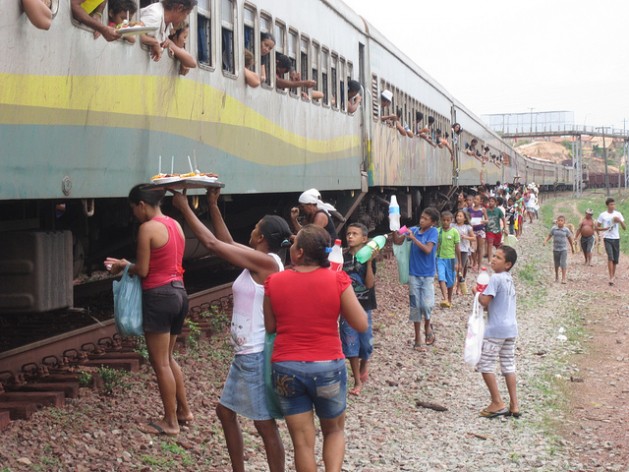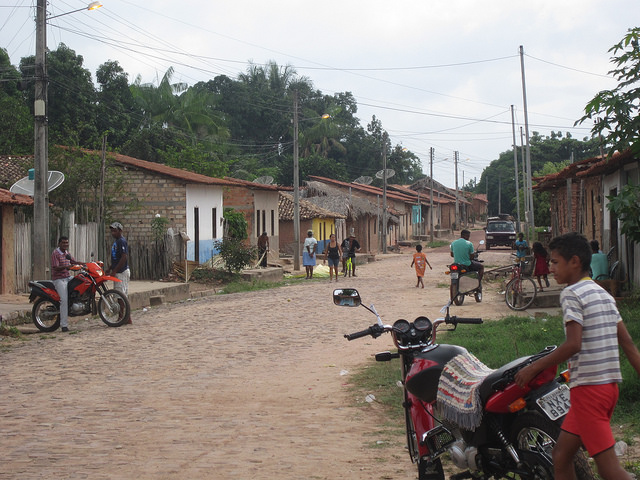Rich Railroad Brings Few Opportunities in Brazil

ALTO ALEGRE DO PINDARÉ/SÃO LUIS, Brazil, Feb 28 (IPS) - The Carajás railroad, regarded as the most efficient in Brazil, runs a loss-making passenger service for the benefit of the population. But this does little to make amends for its original sin: it was created to export minerals and crosses an area of chronic poverty.
Three decades after it was built, the Carajás corridor, or area of influence, of the railway that transports one-third of the iron ore exported by Brazil remains a supplier of cheap labour for more prosperous regions and large projects in the Amazon, IPS found in a visit to the region.3
Auzilandia, a village of 12,000 people and humble dwellings either side of the tracks, "is empty" at the end of every year, according to Leide Diniz. Her husband has gone, "for the second time," over 3,000 kilometres south to the state of Santa Catarina, a three-day bus journey.
He left their three children with her in November to work in a restaurant during the tourist season in the southern hemisphere summer. "He earns some money and comes back," said his wife, who accepts the situation because "there are no jobs here."
For the past few years most of the unemployed workers in Alto Alegre do Pindaré, a municipality of 31,000 people, have migrated to Santa Catarina for seasonal work. Auzilandia is part of this municipality in the heartland of Maranhão, a transition state between the semi-arid northeast of Brazil and the Amazon rainforest.
Accidents, in spite of safety measures
His grandparents were working in the field, his mother was hand-pounding rice in a mortar and his older brother was cutting his hair. No one noticed when the 15-month-old baby crawled across the patio, through the gate and reached the railway a few metres away.
This is how Leidiane de Oliveira Conceição relates the tragic story of how she lost her son.
"The Vale train has brought me only woe and loss. The worst thing was when it killed my grandson, but once it also ran over 14 bred (pregnant) cows of mine," complained grandfather Evangelista da Silva, who is claiming an indemnity for land taken over by the railway.
Vale's trains are regarded as the safest in Brazil.
Safety features include electronic barriers, viaducts, information campaigns and 24-hour patrols that remove "more than 80 at-risk people a month," like those intoxicated with drink or visually impaired, according to Elmer Vinhote, a supervisor at the Carajás Railroad operational control centre.
Accidents and crashes have fallen from 20 in 2009 to "three or four" a year now, he said.
But accidents and legal disputes seem inevitable. Mario Farias' mother was killed by a train in 1996 and they have still not received the indemnity. In Auzilandia, an inebriated old man was saved by the patrol a few months ago, according to local people.

Dozens of families complain of cracks in their houses, caused by the construction of a viaduct over the rails, and are claiming new houses further away, or indemnities.
Two-thirds of the 892 kilometres of the Carajás Railroad go through Maranhão, but this state continues to send workers to many other regions of the country, in general for temporary or precarious work, like artisanal gold mining in Amazonia or harvesting sugarcane.
It is also the main source of the victims of modern slavery, especially in stock raising and charcoal making. Its Human Development Index is next to last among the 27 Brazilian states and its per capita income is the lowest.
The Carajás Railroad and the transnational Brazilian mining giant Vale, that has the concession, will have a new opportunity to aid local development. Its tracks, so far one-way, are in the process of being made two-way, and mining extraction in the Serra dos Carajás (Carajás mountains) in the Amazonian state of Pará is about to be doubled up.
From 2018, some 230 million tonnes a year of the highest grade iron ore on the world market will be extracted.
The railway widening will extend to the deep water port of Ponta da Madeira in São Luis, the capital of Maranhão, which exports the production of Carajás, including manganese, copper and other minerals that make Vale the second largest minerals exporter in the world.
An investment of 19.5 billion dollars is required, most of it in logistics.
At its peak, railroad construction will employ 8,645 workers, Vale said. There will be 1,438 permanent jobs when the dual-track railway comes into operation and the priority will be to hire local people, the company promised.
A drop in the bucket towards development in such a vast area of influence. The most significant aid will come from the social investments of this company, one of the most profitable in Brazil.
A new mining bill, to be approved this year, will compel a small proportion of Vale's income to be spent for the benefit of municipalities that are indirectly impacted by its activities.
To ensure these and other resources and to make better use of them, the 23 municipalities on the path of the railroad in Maranhão have joined forces to coordinate their actions and their relations with Vale.
The company assessed local economic interests and designed "projects for each micro-region along the railroad," according to Zenaldo Oliveira, Vale's director of logistics operations. In one community it may fund a cassava flour mill, in another fruit growing and juice production, he said.
Vale, founded by the state in 1942 and privatised in 1997, only supports education, health and income generation initiatives, he said, because these have been identified as the major problems hindering local development.
At present, with a single track for both directions, there are 12 freight trains daily from Carajás to São Luis. The trains are said to be the longest in the world, with 330 railcars, four locomotives, and each carrying more than 30,000 tonnes of minerals, totalling over 100 million tonnes a year.
On the return journey they carry fuel, fertiliser and other products consumed in the interior.
Passenger trains operating at subsidised fares, because "the local population is unable to afford the real cost," provide the "social benefit" of cheap, permanent transport in a region where the rains often make roads impassable, Oliveira said.
At 15 stops, especially at Alto Alegre do Pindaré, vendors of cold drinks and food, most of them women, swarm to the train offering their wares to the railroad's 360,000 passengers a year through the open windows.
This precarious income may disappear with the new project, as the cars will be air conditioned and the windows will be closed. "We will seek solutions" before the changeover, perhaps organising vendor cooperatives, Vale's Oliveira said.
A workers and vendors cooperative has existed in Alto Alegre for some time, founded with support from Vale. Ten years ago it used to sell food to the railroad's canteen, but "only for a short time," according to its 58-year-old coordinator, Alice Cunegundes, a mother of three.
Afterwards the cooperative, which had as many as 93 members, supplied up to 3,000 meals a day to the mayor's office, until the present mayor, elected in 2012, cancelled the arrangement, knocking the stuffing out of the initiative, she complained.
Supporting enterprise, improving schools and training thousands of workers are some of the social and environmental actions of Vale and its Foundation.
But "they are one-off projects that do not promote effective development in the territory," said George Pereira, the executive secretary of the Itaquí-Bacanga Community Association, another "product of Vale's social investments," which serves 58 neighbourhoods around Ponta da Madeira.
Moreover, they are inadequate compensation for the damages suffered by the population of the Carajás corridor, according to Justiça Nos Trilhos (Justice on the Tracks), a campaign made up of social and religious movements to defend the rights of the people affected by the railroad.
In 2012, its denunciations and those of Articulaçao Internacional dos Atingidos pela Vale (International Network of People Affected by Vale) led to the company being selected for The Public Eye award, created by international organisations like Greenpeace to single out the worst corporate offenders against human rights and the environment.
Fatal accidents, pollution with mineral dust and cracks in houses close to the railway line are some of the impacts on local people.
The railroad must answer for its own sins as well as those of its twin partner, iron mining. It is also part of the Programa Grande Carajás (Grand Carajás Programme), a group of mining, steel, aluminium, pulp and paper, ranching and hydropower companies with which the government intended to develop the eastern Amazon region in the 1980s.
The programme created accelerated deforestation, lethal pollution around iron industry centres, slave labour and other forms of violence, while there was little progress in human development, acording to the statistics.
© Inter Press Service (2014) — All Rights Reserved. Original source: Inter Press Service
Where next?
Browse related news topics:
Read the latest news stories:
- The Growth of One-Person Households Thursday, April 24, 2025
- ‘Noboa Did Not Receive a Blank Cheque: He Will Have to Show Tangible Results’ Thursday, April 24, 2025
- UN Warns of an Imminent Collapse in Haiti Thursday, April 24, 2025
- This Election Campaign Offers Two Opposing Visions of How to Tackle Insecurity Thursday, April 24, 2025
- Rampant Tourism, Climate Change Threatens Varkala's Unique Geodiversity Thursday, April 24, 2025
- A Nation Bleeds While the World Watches: The Tragedy in Sudan Must End Thursday, April 24, 2025
- African Countries Still Underfunding Health by as Much as 50 Percent Thursday, April 24, 2025
- Outrage as Russian overnight attacks on Ukraine cities kill at least nine civilians Thursday, April 24, 2025
- UN Chief, Brazil Gather World Leaders to Reaffirm Commitments Paris Agreement Wednesday, April 23, 2025
- Climate Groups Report 2025 Is Unlikely To Be Hotter Than 2024 Wednesday, April 23, 2025